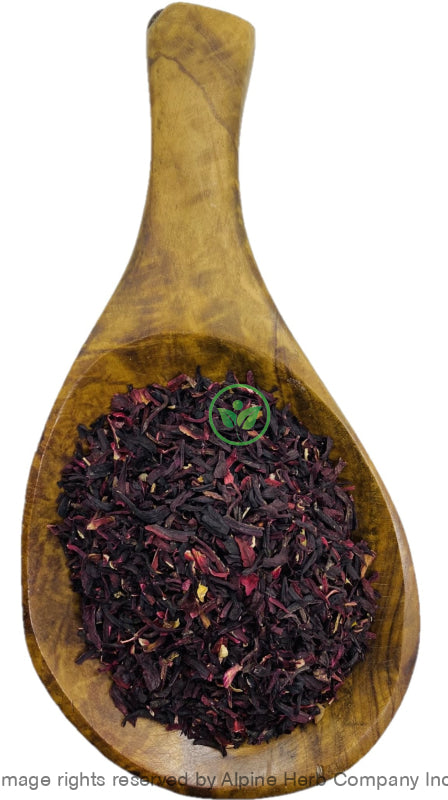Hibiscus Flower Cut Alpine Herb Company Inc.
$ 8,49 $ 5,09
Botanical Name: Hibiscus sabdariffa
Common Name:
- English: Jamaican Sorrel
- Ayurvedic: Ambashtthaki.
- Also, known as: Semparuthi, Hibiskus Mei gui qie, Shan qie zi, karkade,Oseille de Guinee, Hibiscus, Roselle, Sabdariffa-Eibisch, Karcade; Roozera, Rosela, Vinagreira, Rosa de Jamaica, Hawaiian Hibiscus,and shoeblack plant, Shoe Flower, Roselle, Natal Sorrel, Red Sorrel, Sivappu Kashmakki, Pulichai-keerai, Gogu, Seemai, Kaseru, Laal-ambaadi, Patavaa,Patsan, Sembaruthi, China rose, Hawaiian hibiscus, shoeblackplant, Gul-e-Gurhal, Rose mallow, and Chinese hibiscus
Origin: Egypt
Harvested: Cultivated
Parts Used: Flower
General Information:
The genus Hibiscus includes more than 300 species of annual or perennial herbs, shrubs or trees. An erect annual herb grows up to 5-8 feet tall with lobed leaves and white or yellow flowers with dark centers. The fleshy red sepals are surrounded by an outer row of bracts. The leaves are alternate, 5-10 cm long, green with reddish veins and long or short petioles. The leaves of young seedlings and upper leaves of older plants are simple; lower leaves are deeply 3-7 lobed; the margins are toothed. Flowers, borne singly in the leaf axils, are up to 10 cm wide, yellow or buff with a rose or maroon eye, and turn pink as they wither at the end of the day. At this time, the typically red calyx, consisting of five large sepals with a collar of 8-10 slim, pointed bracts around the base, begins to enlarge, becomes fleshy, crisp but juicy, 3-5 cm long and fully encloses the velvety capsule, 1-2 cm long, which is green when immature, five valved, with each valve containing 2-4 kidney-shaped, light-brown seeds, 2-4 mm long and minutely downy. The capsule turns brown and splits open when mature and dry. The calyx, stems, and leaves are acid and closely resemble the cranberry in flavor. Seeds are mostly directly sown into the fields but plants can also be grown from transplanted seedlings or even cuttings.
Tea and various cold drinks are very popular in African and Latin American countries.The seeds are eaten roasted or ground in meals, while the leaves and shoots are eaten raw or cooked, or as a sour-flavored vegetable or condiment but its main use is as a natural food color and sweet-sour flavor in herbal teas. In some countries the leaves are eaten green or dried, cooked with onions and groundnuts, while the cooked leaves are eaten as vegetables as well. The seeds are roasted or ground into a powder and used in meals, such as oily soups and sauces. Hibiscus is one of the most key species grown commercially as a fiber plant and became increasingly important in India after independence and partition with Pakistan, where the most key jute growing areas are. It is used as jute, additional in making clothing, linen, fishing nets, ropes, and similar products.
How to use:
Hot Infusion:
The basic method for dried herbs and flower is, take 2-3 tablespoons of dried herb in a cup or teapot. Pour hot water over it and cover it with lid for 10-30 minutes. Hot water is needed to draw out the antioxidants, enzymes, vitamins, flavonoids, and volatile oils from the botanicals. Strain and squeeze out as much as liquid as possible and enjoy!
Tips:
- You can sweeten your herbal tea with a bit of honey, natural fruit juice, stevia leaves powder and or licorice root powder.
- You can make ice cubes or pops by freezing tea in ice trays or pop molds.
Precautions:
You should consult with a qualified healthcare practitioner before using any herbal products, particularly if you are pregnant, nursing, or on any medications.
All information on this website is for educational purposes ONLY.
This information has not been evaluated by Health Canada.
This information is not intended to diagnose, treat, cure, or prevent any disease.
| Unit Size | 100g, 200g, 400g, 1kg |
|---|
Prompt shipping and expert packing
Thanks to our longstanding association with UPS FedEx DHL as well as other leading global carriers, we can offer a variety shipping options. Our warehouse staff is highly trained and will be able to pack your goods in accordance with our precise and exact specifications. Your items will go through an exhaustive examination before they will be securely packaged before being delivered. We ship to hundreds of thousands of customers daily in different countries. This is a sign of our determination to become the largest online retailer worldwide. Warehouses and distribution centers are located throughout Europe as well as in the USA.
Note that orders containing multiple items are processed according to the particular item.
We will thoroughly inspect all items ordered before shipping. Most orders are shipped within 48 hours. The delivery time will be between 3 and 7 working days.
Returns
The stock market is always changing. It's not entirely managed by us since we're involved with several entities, including the factory and the storage. Therefore, the actual inventory could fluctuate at any moment. Please be aware that it is possible that your order could be out of stock after you've placed your order.
Our policy lasts for 30 days. If it's been more than 30 days since the date you purchased your item We're sorry to say that we can't offer you a full exchange or refund.
You can only return a product if it is unused and still in the same state as when you received it. The item should be in the original packaging.
Related products
Herb Whole
Herb Whole
Herb Whole
Herb Whole
Herb Whole
Herb Whole
Herb Whole
Herb Whole
Herb Whole
Herb Whole
Herb Whole
Herb Whole
Herb Whole
Herb Whole
Herb Whole
Herb Whole
Herb Whole


































